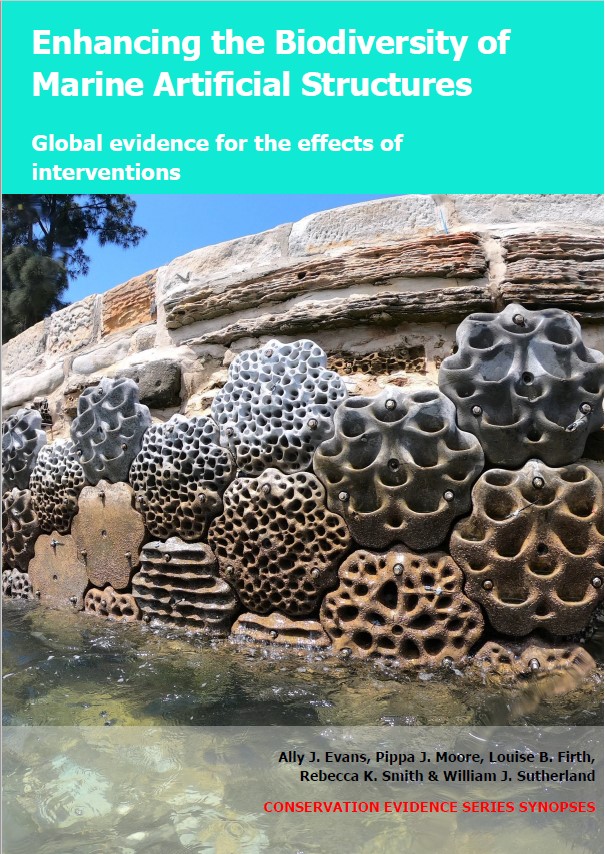Create short flexible habitats (1–50 mm) on subtidal artificial structures
-
Overall effectiveness category Awaiting assessment
-
Number of studies: 3
View assessment score
Hide assessment score
How is the evidence assessed?
-
Effectiveness
not assessed -
Certainty
not assessed -
Harms
not assessed
Study locations
Supporting evidence from individual studies
A randomized, controlled study in 2008 on two subtidal swimming-enclosure nets in Sydney Harbour estuary, Australia (Hellyer et al. 2011) found that creating short flexible habitats (frayed-netting) on enclosure-net panels had mixed effects on seahorse Hippocampus whitei and mobile invertebrate abundances, depending on the survey week and invertebrate species group. Over two months, net panels with frayed-netting had higher seahorse abundance (1–3 individuals/panel) than panels without flexible habitats (0–1/panel) during six of seven surveys, but similar abundance during the other survey (frayed-netting: 1/panel; without: 0/panel). Mobile invertebrate abundances on panels with and without flexible habitats varied depending on the species group and survey week (see paper for results). Short flexible habitats were created on polyethylene rope swimming-enclosure nets (100 mm mesh size) in March 2008 by attaching clumps of frayed nylon netting (50 mm length) at knot intersections (‘frayed-netting’). Three net panels (length: 0.3 m, height: 1 m) with frayed-netting and three panels without were randomly arranged along each of two enclosure nets (depth not reported). In May 2008, sixty-three seahorses were released onto the nets. Seahorses were counted on panels with and without flexible habitats over two months and mobile invertebrates (seahorse prey) were surveyed using a suction-pump over three months.
Study and other actions testedA replicated, randomized, controlled study in 2012–2013 on a subtidal dock in Sydney Harbour estuary, Australia (Lavender et al. 2017) found that creating short flexible habitats (polyethylene turf) on settlement plates altered the non-mobile invertebrate community composition on plates and had mixed effects on the mobile invertebrate community composition and invertebrate abundances, depending on the turf length and species group. After three months, non-mobile invertebrate community composition differed on settlement plates with longer and shorter turf, and both differed to plates without turf (data reported as statistical model results). Plates with longer turf also supported different mobile invertebrate composition to plates with shorter turf and without turf, which were similar. Non-mobile invertebrates were less abundant on plates with turf (0–7% cover) than without (4–28%) in nine of 14 comparisons, but similar in the other five comparisons (with turf: 5–25%; without: 4–28%). Mobile invertebrates were more abundant on plates with turf (2–324 individuals/plate) than without (0–50/plate) in 22 of 28 comparisons, but similar in six comparisons (with turf: 2–58/plate; without: 1–50/plate). Plastic settlement plates (100 × 100 mm) were made with and without short flexible habitats (polyethylene turf). Plates with turf had either longer (18 mm) or shorter (2–3 mm) blades (1.5 mm width). Twelve of each were randomly arranged at 3 m depth beneath a dock with turf facing downwards in October 2012. Invertebrates on plates were counted in the laboratory after three months.
Study and other actions testedA replicated, randomized, paired sites, controlled study in 2014 on eight subtidal pontoons in two marinas in the English Channel and the Élorn estuary, France (Leclerc & Viard 2018) found that creating short flexible habitats (polypropylene turf) on settlement plates did not increase the invertebrate species richness or the mobile invertebrate abundance on plates, but had mixed effects on the non-mobile invertebrate abundance and the community composition, depending on the turf density and site. Mobile invertebrate species richness and abundance was similar on plates with high-density turf (22–33 species/plate, 189–1,093 individuals/plate), low-density turf (23–34 species/plate, 194–1,132 individuals/plate) and plates without turf (19–27 species/plate, 132–1,019 individuals/plate). The same was true for non-mobile invertebrate species richness (high-density: 6–10 species/plate; low-density: 8–11/plate; no turf: 7–12/plate), and their abundance at one of two sites (high-density: 95–143% cover; low-density: 90–114%; no turf: 101–119%). At the second site, abundance was lower on plates with turf (high-density: 108–156%; low-density: 117–151%) than without (120–192%). Invertebrate community composition differed on plates with and without turf in four of eight comparisons, but was similar in the other four (data reported as statistical model results). Plastic settlement plates (180 × 180 mm) were made with and without short flexible habitats (polypropylene turf). Plates with turf (blade length: 30 mm; width: 2 mm) had either high (100% cover) or low (50%) turf density. One of each was randomly arranged vertically at 1 m depth beneath each of four pontoons in each of two marinas in May 2014. Invertebrates on plates were counted in the laboratory after three months.
Study and other actions tested
Where has this evidence come from?
List of journals searched by synopsis
All the journals searched for all synopses
This Action forms part of the Action Synopsis:
Biodiversity of Marine Artificial Structures
Biodiversity of Marine Artificial Structures - Published 2021
Enhancing biodiversity of marine artificial structures synopsis





)_2023.JPG)














